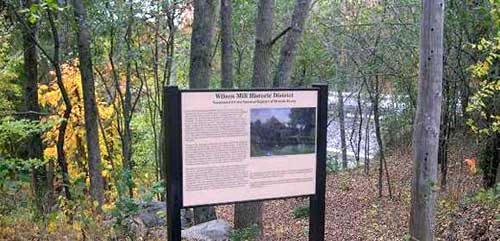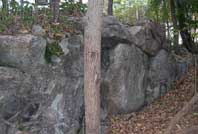


 |
 |
 |
 |
 |
 |
 |
 |
 |
 |
History of Wilson Mill
Mills were vital components of New England towns in colonial towns for social as well as economic reasons. Indeed, news and gossip were exchanged there as frequently as commodities and currency, perhaps more. Small farmers who grew only enough grain for their own families and livestock, or needed lumber from their own wood lots cut to build and maintain their farms, brought their grain and logs to the local grist and saw mills. Some might be lucky enough to have surplus to sell or trade; few had large enough farms to count on it. Everyone needed the mills, though, so it is not surprising that in 1683 the citizens of Billerica voted in favor of the construction of a road to John Wilson's grist mill on Vine Brook. This is the earliest record of the presence of a mill at this site.
By 1839 a cider mill had been added near the other mills which were still in operation though they had passed through various owners. In the days before town water and sewer systems when people depended on their own cisterns and wells, cider was an important commodity. When the wells were low, or subject to contamination from livestock and stagnation, beverages such as beer and cider were safer to drink than water. Johnny Appleseed, that colorful American folk hero, is remembered because of cider, not table fruit.

Industrialization brought great changes to America in the nineteenth century, but more slowly to the rural areas than to the cities. By the 1820's steam power was commonly in use in England, but in America water power remained cheaper. By that time paper making machines were becoming available in the US, greatly increasing the production capacities of its paper mills. In 1840 a paper mill was built on Vine Brook, replacing a gristmill. The paper mill thrived, and was a major source of employment until it burned in 1846. After the fire, the town's population fell by a tenth.
The increasing economic importance of railroads in the late nineteenth century is reflected in Bedford in the shifting of the town's industrial center from the mills to Depot Square in the late 1870's. There was still a saw mill at Vine Brook in 1889, however, possibly connected to the Bedford Lumber and Manufacturing Company located in Depot Square. The exact date when milling operations ceased along Vine Brook is not known, but the remaining mill buildings were probably demolished in the 1920's.
For the rest of the twentieth century, the former mill area lapsed into obscurity. Farm land was replaced with residential neighborhoods, and the creation of the major road ways greatly diminished the mill pond, and the spillways and mill races. Land adjacent to the roadways became dumping areas for the odd car part, tires, and construction and road waste. By the time the land was acquired by the town, it offered little cause for visitors to linger, except for those who knew its quiet charms away from the road ways, and how to get a glimpse of the waterfall by scrambling down the steep sides of the old mill race. The Wilson Mill Park Committee does not seek to restore the area to some imagined state of lost glory. Rather, it seeks to reacquaint the town with the area as it is now by removing waste dumps; removing invasive plant species and restoring native New England vegetation to support wildlife; protecting the remaining vestiges of the old mill structures, and improving access to the area for foot and bicycle traffic.

The goal of the Wilson Mill Park Planning Committee is to protect, foster and advocate for the historic mill site, surrounding natural habitat and passive recreation opportunities available at Wilson Mill Park for the people of Bedford to enjoy.